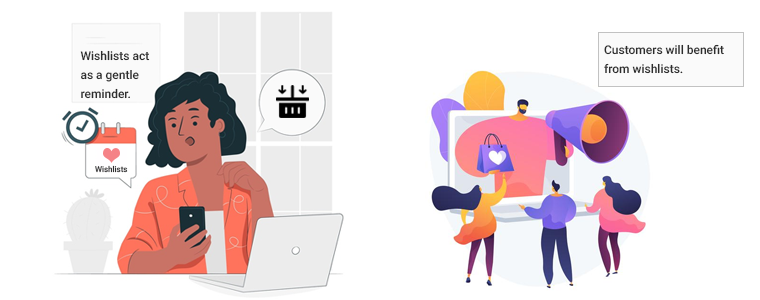A wishlist feature helps an e-commerce store to turn prospective customers into real customers even if they aren’t ready to make an initial purchase. Wishlists are one of the most significant e-commerce features that can help you boost your sales.
Offering wish lists is a good way to minimize shopping cart abandonment and close purchases from customers who expressed interest but didn’t buy. Wishlists favor both consumers and merchants: they offer a convenient way for customers to remember a product while also enabling merchants to track product demand beyond a single sale.
What is a wishlist?
A wishlist allows consumers to create customized collections of things they want to purchase and save them in their user account for future reference. Wishlists show a customer’s interest in a product but not their desire to buy it right away.
Customers’ wish lists are sets of preferred items saved to their user accounts, for which they have shown curiosity but not an imminent interest in purchasing them.
How wishlist helps your eCommerce business?
Increases engagement
Wishlists act as a gentle reminder. Creating a wishlist does not indicate that you would purchase products right away. They serve as reminders to buy the stuff you’ll need in the future and are critical as consumers are searching for ways to organize their lives.
Customers will benefit from wishlists. To save a wishlist on most eCommerce websites, you must first build an account. Customers can get more information about the items on their wishlist by creating an account. Customers would be able to justify purchasing goods as a result of this education, as well as interact more with the store to create loyalty.
Higher retention rate
A customer often returns to your store if they have added something in the wishlist that they loved. But they don’t necessarily find that product available when coming back. It’s critical to inform customers when a product is out of stock and to provide a way to contact them when it returns. For this reason, many retailers include a special “Remind me” button. If something on a user’s wishlist is back in stock, send them an email. It can also be a very simple email, with only the items and nothing else – no need to cram it with extraneous information.
Personalized Marketing
Wish lists are a happy medium between buying and forgetting: many shoppers aren’t ready to buy right now, but they want to remember the product and/or store for later. Wish lists can entice users who would not otherwise sign up for an account to do so; if they opt-in for email notifications, these prospects can then be included in drip marketing campaigns.
Increase Sales
With more traffic to your e-commerce website, you’re more likely to achieve your revenue goals.
The truth is that your new visitors may discover something worth sharing with others in addition to knowing that their friend or loved one wants your products. The best part about your wishlist feature is that it can be used all year for your potential customers’ special occasions.
Conclusion: If you haven’t considered providing a wishlist to your customers, you may be allowing your competitors to increase their profits. The wishlist will not only make your life easier, but it will also be beneficial to your potential customers. Why not avoid returns and encourage sales instead?
This may interest you:
- Must-have Features for your Fashion-Focused PrestaShop Store
- Compel the Customer to Return to your Store with Back in Stock Module
- 8 Things that make a Perfect Mobile Product Page







